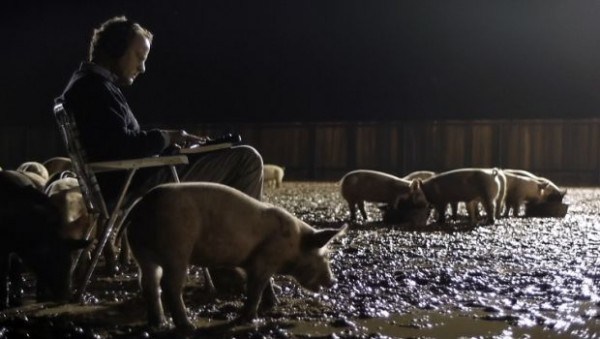If I see another motion picture in 2013 that is as
remotely as intelligent or mature as Upstream
Color, it will be a very good year for movies. One can go years
between films this well-conceived & executed. It seems to have done well in
an art-house
cinema in New York, but the self-distribution plan by writer-director-lead
actor-producer-composer-editor-cinematographer Shane Carruth
found it playing in the basement auditorium of a science museum in Philadelphia
where I caught it on the second day of
its release showing to a crowd in high single digits. This in spite of a near-rave
review from the Philadelphia
Inquirer just one day before. Carruth, who settled on the do-it-yourself
distribution scheme even before the film showed at Sundance, is undoubtedly
correct in his presumption that the old model for getting films to people is
breaking down for films just as much as it is for books, music and just about every
other intellectual endeavor (heads up,
art dealers – they’re coming for you). But his cobbled-together alternative
really isn’t working unless the stream-or-download distribution that starts – hey – this Tuesday catches on. I’m here to tell you it’s worth spending twenty
bucks, give or take, to see something extraordinary. But if it’s on a big
screen, do that – even if it’s in the basement of a science museum. As film, Upstream
Color is gorgeous. And the sound is to cinema what Red Desert once was to the use of color.
I could recount the
narrative of Upstream Color, but you
wouldn’t understand it because the protagonists, played by Carruth and Amy
Steimetz, don’t and the film really wants you to feel their sense of confusion
even when it flirts with omniscience. Steven Soderbergh has been quoted as
calling Carruth the “illegitimate offspring of David Lynch & James Cameron,”
but the directors who seem to be the hovering godparents of this project are Wenders,
Tarkovsky & early Polanski. Envision, if you will, Wings of Desire blended with Rosemary’s
Baby, seasoned with just a sprinkling of Babe (& Babe in turn
as read through Soylent Green), all filtered through the depressed
lens of the driving sequence in Solaris. Did
I say you wouldn’t understand it? Now consider that much, maybe all of this
hinges on the text of Thoreau’s Walden.
You can imagine the expression on some studio exec’s face as that was pitched to them. The glaze over his eyes must have been instantaneous.
Suffice it to say that bad things happen to some decent
enough people, very bad things that
they can’t explain, comprehend or even really remember. They’re rescued, sort
of, but it isn’t clear if the rescuer is part of the same conspiracy that has
already ruined their lives, or on another team altogether. And there are
elements of the rescue that are as appalling, as genuinely devastating as
gutting their bank accounts, careers,
reputations & relationships. They’re left among the walking wounded, barely
getting by, very much like people who are afraid to tell you that the probes of
their alien abduction really hurt. When
the rescuer checks in on them, they don’t even notice his presence. Or maybe he’s
invisible. But the evidence of PTSD is spilling out in every direction.
By chance, perhaps¹, Jeff & Kris, two of these
victims, come together & recognize their neediness under a common wound
that they can’t even, at least until the very end, discuss. Jeff achingly wants
to be with Kris & Kris isn’t sure she ever wants anyone to touch her again.
Meanwhile the rescuer is big into ambience, a meditative angel as sociopath as
sound engineer: monster Buddha. What
Jeff & Kris can’t say, they can hear & then begin to see or sense under
water, & then finally into passages of text until the momentum of it all
cascades into consequences for everyone. Perhaps.
This is the saddest film with a happy ending that I have
ever watched. Steimetz’ Kris & Carruth’s Jeff are smoldering triumphs of
understatement. You want her to call the cops, but you know they wouldn’t
believe her. A psychiatrist thinks she’s
schizophrenic. Jeff thinks he became a heroin addict – that might explain why
he doesn’t remember being a junky. [Think
about that for a moment.] What do blocks of concrete sound like when they
topple over? That’s what the rescuer wants to know. That & what do I do
with these mutant pigs? You will never trust blue orchids again.
If the problem with narrative lies in the fact that an
author already knows too much, Carruth has tried to show what might occur if
you erased all the back story. And then some. Presume for a moment that the
rescuer – who is called The Sampler in the credits – really isn’t a part of the
eco-chain of botanists, chemists & dealers who are putting their worms into
your body – perhaps he’s a deprogrammer or a farmer that depends on your
product, that product being you. Removing him disrupts the chain, but for just
who exactly, and how long? What if you are ultimately leaving the next
generation of victims without a rescue, regardless of the brutality of its
consequences? Then all that cuddling with piglets as tho they were babies has a
very different context and content.
Upstream
Color is all about the questions, leaving the answers pretty
much up to you. As indeterminate as it is, there is not one second wasted in
the execution of the film. Every shot, every sound, seems utterly necessary. In
this way, you might read it as an argument for intelligent design, intelligent malevolent design. Think
about it.
¹ By film’s end, you won’t think it’s chance in the
slightest. But doesn’t that mean that the rescuer must have foreseen what was
coming? And how then do we interpret that?






